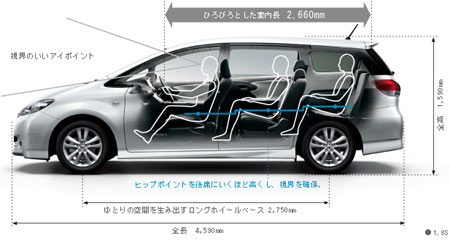One car that puts the Toyota design right at the top, would be the Toyota Wish. The Toyota Wish which is sold in Malaysia through UMW Toyota, is fully imported from Thailand. Overall its a modern and sporty looking vehicle with great substance in driving performance, that can cater for 7 persons comfortably or the additional space when needed.To me, the greatest characteristics found in this great vehicle would be its appealing exterior and interior design that is accepted by most car lovers. Launched first in the year 2003 in Japan and “officially” by UMW Toyota, in May of 2006 in Malaysia. This model has done tremendously well in the market. After having a test drive on the Toyota Wish, you would definitely find it to be some what an outstanding driving experience.
The closest and most usual competitor for the Toyota Wish would be their constant brand rivals, the Honda Stream. But if you look into the specifications of the Toyota Wish, you would notice that its larger and a more spacious vehicle. Compare the exterior of the Toyota Wish which is at 1,745mm and the Honda Stream’s exterior of 1,695mm, thats a wider space of 50mm. Interior wise the Toyota Wish has a length of 2,670mm compared to Honda Stream’s interior of 2,560, that’s 110mm of extra length.
Toyota has not left out styling when they designed the Wish, as the exterior has a style that stresses sportiness as well as improving the vehicle’s aerodynamics. For most young executives its a practical choice as the Toyota Wish has features that enhances the modern and upmarket image that they can relate to.

There are so many advantages that you will be able to find in the Toyota Wish, one such advantage is their ability to transform their seats into different modes of operation, such as the; 7 passenger mode, Space Mode, Limousine Mode (5-passengers), Long Space Mode, Relax Mode and the Table Mode (good when go out for your picnics) .
Technicals aspects in this vehicle is also maintained as with all their other vehicles, where the main source of power coming from their 2.0S (1,998cc) 1AZ-FE engine which is a In-line 4-cylinder, 16 valve, DOHC, VVT-i provider. This engine compared to the Honda Streams i-VTEC offers a better acceleration and response which are essential for city driving with higher torque and comparable engine output. To define this take the example of a 0-100km/h test, where the Toyota Wish would take 11.11 seconds compared to Honda Streams 11.96 seconds. And we did a Standing Start Acceleration Test 0-400m, and found the Wish to reach it by 17.89 seconds compared to Streams 18.33 seconds.
The transmission found in the Toyota Wish is a 4 speed automatic sequential type. This enables the car to be driven in a manual transmission like way. Once the gear is set at “S” position, the shifting occurs by choosing either “+” (upshift) or “-” (downshift).

Macpherson Strut Suspensions with Stabiliser is used in the front and the rear is installed with Double Wishbone with Stabiliser, which in the end provides good handling and great ride comfort. To complement the ABS system, the Wish comes with 15″ ventilated disc brakes for the front and 15″ solid disc brakes for the rear.
Various other cutting-edge technology features are also adopted to prevent accidents from happening, like their active safety modes; VSC with TRC, ABS with EBD, BA (Brake Assist) as well the passive safety mode; GOA Body, Dual Front SRS Airbags, Front Seatbelts with Pretensioner and Force Limiter.
The audio system included in the Toyota Wish has a capability of playing CD/MP3/WMA disc’s, where sound is distributed through six speakers.
Currently if you are planning to purchase a Toyota Wish, get ready to make a selection from five different colour choices - Super Red, Black Mica, Champagne Metallic, Silver Metallic and Pacific Blue. As with all the Toyota vehicles sold through UMW in Malaysia, these vehicles come with a 3 year warranty or 100,000km (whichever comes first). Browse my earlier topic on “Toyota - June Promotion” to see what’s in store for the intended buyer. Starting Price is at RM152,686.10 (without insurance)





















































































